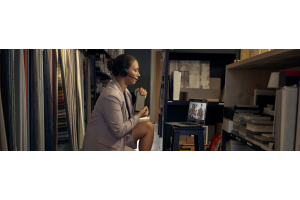How to Make Your Desktop Look Aesthetic
January 14, 2022

You spend a lot of time at your computer, so it only makes sense that you’d want your desktop to reflect your personality. Whether you've always been a fan of custom wallpapers and fonts or this is your first time customizing your computer's look, there are many ways to make your PC more beautiful and attractive.
By following the tips in this article, you can help your Windows 10 PC look cooler than ever.
Steps to make your desktop look cool
Let’s face it: the standard, out-of-the-box look of a Windows PC desktop is a bit dull. Use these tips and tricks to give new life to a boring desktop by creating an aesthetic computer screen experience.
1. HIDE YOUR DESKTOP ICONS AND TASKBAR
A minimalist look is all the rage, and one of the quickest ways to create a clean PC aesthetic is to hide all those default Windows icons. Here’s how you can do it:
- Type “Settings” into the bottom right search bar in the Start Menu.
- Select the Settings app.
- Click Personalization.
- Select Themes and look for the Desktop icon settings. It should be to the right, but you may need to extend the Settings app window to see everything.
- Uncheck all the Windows icons you don’t want to see on your desktop.
You can also hide your taskbar.
- Navigate to the bottom of the screen (or wherever your taskbar is docked).
- Right-click on the taskbar and choose Taskbar settings.
- Switch on the mode called “Automatically Hide the taskbar in Desktop.”
You can also tweak other taskbar settings so it takes up less real estate on your screen.
2. SET NEW DESKTOP WALLPAPER
Changing the wallpaper is an easy and classic move to make when personalizing your computer. Simply go to Settings again and select the Background tab. As a quick note: “Wallpaper” and “Background” are used interchangeably within the Windows settings menus.
You can choose to either make your wallpaper a static picture of your choosing or you can set up a slideshow of rotating images. If you need cool wallpapers, Microsoft includes a link within these settings that brings you new images every day. You can also select your own artwork, a family photo, or something that inspires you.
3. CHANGE LOCK SCREEN BACKGROUND
If you leave your computer for any length of time and the energy-saving features kick in, you'll probably see a different photo pop up on your screen. This is the lock screen background, and it remains until you unlock your computer.
If you don’t set a particular background, Microsoft will create one for you. It typically consists of vivid photographs of places and items from around the world.
While those images are certainly attractive, you can set your own lock screen background that better matches your aesthetic. You can do this in the same Settings window that you used to set wallpaper.
4. SET ACCOUNT PICTURE

If you don’t pick a customized account picture, your avatar will appear as a gray image with a white face outline. To create something more personal and cool:
- Go to your Settings, then Accounts, and Your info.
- Go to Create your picture.
- From here, you can use your webcam to take a photo of yourself. You can also upload an existing photo or anything else you’d like.
Now anytime Windows uses your profile photo, you’ll see this new picture instead.
5. REVISE START MENU
If you’re like the typical PC user, you use the Start Menu many times during the day. But have you noticed how it gets so full of junk and unused icons? To clean this up and streamline your Start Menu experience, simply do the following:
- Navigate to the Start Menu and right-click on any program tile you don’t want to see there anymore.
- Select Unpin from Start.
This simple task should help clean up your PC. Many computers come loaded with useful apps but they may also contain games or utilities you don’t necessarily use often, if at all. You should also use this opportunity to drag the apps you love from the Start Menu list on the left to the tiles featured on the right.
6. ORGANIZE YOUR DESKTOP
There are two types of people in the world: those with clean desktops and those with absolutely nightmarish desktops. Even if you don’t always keep your desktop organized, cleaning it up may help your computer run more smoothly.
The quickest way to do this is to right-click anywhere on the desktop (not on a file or folder) and choose Sort by item type. This will put all of the similar items together. You can then choose the select function to drag and select a group of files or folders you want to move or delete at once.
You can move photos to your photos folder, for example, or Word documents to your Documents folder. Getting things off your desktop will just make you feel better! And don’t forget to empty your recycling bin after throwing a bunch of stuff away.
7. CUSTOMIZE SOUNDS

While Windows 11 introduces some new sounds to the mix, the Windows audio experience hasn’t changed too much in recent years. But if you’re tired of the traditional chimes and beeps you’ve come to know, consider changing things up with some new sounds.
- Navigate to the Settings window.
- Click on Sound.
- Click over to the Sound Control Panel and choose the Sounds tab.
You can either change sounds to what's available or even upload your own .WAV files. To try out any sound before you confirm it, just use the Test button. This won’t do much to make your computer screen aesthetic, but it can make your computer time more fun.
8. INSTALL AND CUSTOMIZE RAINMETER
If you feel frustrated by the idea of going through all your settings or you’re not creative enough to come up with great visual combos on your own, consider using Rainmeter. It comes loaded with customizable skins and graphics to create a stunning experience every time you log on. The only thing is it may take some time for you to get fully comfortable using it.
Fortunately, there are plenty of tutorial videos on YouTube to help you get started. Just watch a few flips and you’ll be on your way to a truly aesthetic PC look in no time.
9. REPLACE ICONS AND FONTS
If you want to freshen up your look even more, you could replace your current icons and fonts with something completely different. You can find icon packs online, but look for clean and simple designs. They’ll go with anything and help to create a more aesthetic look.
Consider fonts with a similar style. You can replace your existing fonts with some from a downloaded font pack by going to Settings and clicking the Fonts tab. Choose from existing fonts, drag and drop a downloaded font pack you found online, or click to search the Microsoft store for new ones.
10. USE CONKY OR ANOTHER DESKTOP ENVIRONMENT
This final tip is a pro tip, and you should only use it if you feel comfortable tweaking your settings. It’s also available with customization options for Linux users.
It’s recommended that you watch some YouTube tutorial videos for how to install and customize Conky. Basically, it’s a tool that changes your themes and widgets by editing the original ~/.conkyrc file.
If you’ve never used a tool like this before, change just one element at a time to see how the changes look on your computer. You can always change it back. As you get more comfortable changing things in Conky, you can do more than one change at a time and create an entirely new look for your PC or computer.
What about pre-made themes?
If you want a quick PC makeover and have no time or interest in playing around with desktop background settings or custom color palettes, consider using a premade theme. You can find these online at the Microsoft store, and they range from beautiful art and nature themes to video game and movie themes.
Summary
It can take some time to get your aesthetic desktop just how you want it, but the good news is that you have complete control over just about every element. And as you come up with new ideas for looks and sounds, feel free to experiment. There's very little you can do to mess up a PC with these basic settings adjustments. They are mostly aesthetic and do little to impact your computer’s performance.
Note that these tips were designed mostly with Windows 10 users in mind. If you updated to Windows 11, these fixes may differ slightly. Feel free to search within the Help guides of your settings app to see how to make these same adjustments on the newest Windows OS.
About the Author: Linsey Knerl is a contributing writer for HP Tech Takes. Linsey is a Midwest-based author, public speaker, and member of the ASJA. She has a passion for helping consumers and small business owners do more with their resources via the latest tech solutions.
Article reposted with permission from HP Tech Takes






